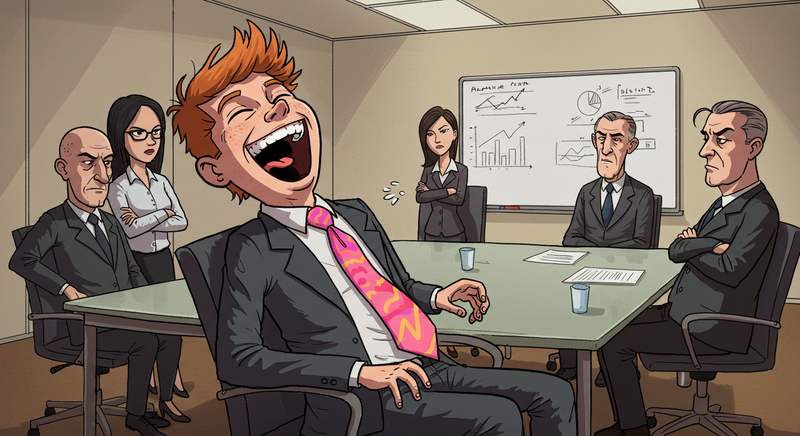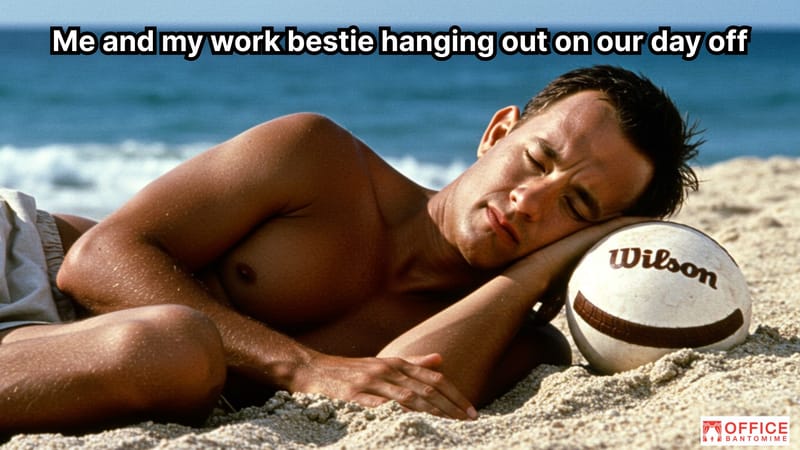Should you be allowed to sleep at your work desk?
Is desk napping a productivity hack or a potential pitfall? Explore the pros and cons of this controversial trend and discover innovative solutions for workplace rejuvenation.
In a world where the hustle never stops and the demands of work and life seem relentless, a crucial question arises: should you be allowed to catch some Z's at your work desk? The answer might vary depending on whether you're working from the comfort of your own home or within the confines of a corporate office.
Let's face it, getting the right amount of sleep is nothing short of essential. Yet, the modern world often robs us of those precious seven or eight hours required to recharge our batteries. Our lives have become busier than ever before, and it's all too easy to forget to switch off when we're constantly tethered to our smartphones and electronic devices. Late into the night, we find ourselves endlessly scrolling through the internet, hunting for job opportunities to escape the clutches of our dead-end jobs, or indulging in the guilty pleasures of streaming shows on Netflix and watching endless reels of TikTok, Instagram, Facebook, and perhaps even a little something more... explicit.
So, it's no wonder that when we finally manage to drag ourselves to work and squeeze onto a bus or train, we secretly pray for the commute to stretch into eternity. Why? Because it's our one chance to sneak in a bit of shut-eye, desperately trying to recover from the sleepless night before.
Once we shuffle into the office, the battle to stay awake begins. We strive to remain alert and attentive for the next seven hours, all while staring at a monitor or sitting through seemingly endless meetings. Our souls are sucked into the vacuum of the office environment as we interact with colleagues and juggle a multitude of draining applications.
Now, picture this: you're scanning the office for a comfy couch or even a discreet nap spot, but all you find are sterile, uncomfortable office chairs and desks. Why shouldn't we lay our weary heads down on our desks and grab a few moments of much-needed rest? After all, isn't sleep a universal necessity?
The question remains: would this daring act of workplace siestas be met with disdain and disapproval from your colleagues and higher-ups?
Disadvantages Of Sleeping At Your Desk
Disadvantage 1: The Dreaded Sore Neck: One of the most immediate and undeniable drawbacks of desk napping is the risk of waking up with a sore neck. The makeshift pillow provided by your folded arms or a stack of papers can leave you feeling less than refreshed.
Disadvantage 2: The Wrong Impression: Picture this: you're in a bustling office, and customers or clients are present. Now, imagine if everyone decided to take a nap simultaneously in an open-plan workspace. This scenario can create an unprofessional image and give off the wrong impression to outsiders. It's crucial to maintain an air of diligence and professionalism, especially when your reputation is on the line.
Disadvantage 3: Potential Senior Management Disapproval: While it may be tempting to steal a few moments of shut-eye at your desk, it's important to note that senior management may not take kindly to this practice. Even if some higher-ups engage in clandestine desk napping behind closed office doors, they may frown upon their subordinates doing the same. This could lead to friction within the workplace and jeopardize your professional standing.
Disadvantage 4: Reduced Privacy: Napping at your desk often means sacrificing your privacy. Colleagues and supervisors can easily spot you in a vulnerable state, which may invite unwanted comments or judgments.
Disadvantage 5: Disturbed Rest: Office environments can be noisy and unpredictable. Unexpected interruptions, phone calls, or loud conversations can disrupt your precious nap, leaving you more tired and irritable than before.
Disadvantage 6: Cultural Norms: The acceptability of desk napping can vary widely depending on the workplace culture. In some organizations, it might be seen as a sign of dedication and commitment, while in others, it could be viewed as laziness or unprofessionalism.
Disadvantage 7: Legal Implications: In some regions, taking naps during work hours might have legal implications, such as violating labour laws or company policies. It's essential to be aware of your company's stance on desk napping to avoid potential consequences.
Disadvantage 8: Productivity Loss: While napping can boost productivity for some, it may have the opposite effect for others. If you struggle to wake up or feel groggy after a nap, it could hinder your ability to perform effectively.
Advantages Of Sleeping At Your Desk
1. The Power Nap Solution: Have you ever found yourself stuck on a complex problem, desperately seeking a solution that seems just out of reach? It turns out that a brief 10-minute nap might hold the key to unlocking your creativity. Researchers have found that a short nap can enhance problem-solving abilities, making it easier to tackle challenging tasks with renewed vigour.
2. Supercharge Your Productivity: We often hear that time is money, but what if we told you that sleep is productivity? By taking a quick nap at your desk, you can recharge your brain, giving it the energy it needs to tackle a multitude of tasks efficiently. A well-rested mind is like a well-oiled machine, capable of churning out quality work in less time.
3. A Happier, More Productive You: Picture this: you're well-rested, your mind is sharp, and you're feeling on top of your game. It's no surprise that this translates into a happier and more productive worker. When you're not battling fatigue, you're more likely to approach your tasks with enthusiasm and a can-do attitude.
4. Say Goodbye to Sick Days: Sleep plays a critical role in maintaining a robust immune system. By catching those much-needed Z's at your desk, you're less likely to fall victim to the office bug that makes its rounds. This means fewer sick days and more time doing what you love—working productively.
5. A Shield Against Health Problems: The benefits of desk napping extend beyond immediate productivity gains. Getting enough rest can significantly lower your risk of developing serious health problems, such as heart disease and diabetes. It's a simple yet powerful way to invest in your long-term well-being.
6. Enhanced Memory and Learning: Naps can do wonders for memory consolidation and learning retention. If you want to absorb and remember new information more effectively, a short nap during the day can work wonders.
7. Mood Booster: Sleep has a direct impact on your mood. A quick nap can help alleviate stress, reduce irritability, and enhance your overall sense of well-being. You'll find yourself better equipped to handle workplace challenges with a smile.
8. Creativity Unleashed: During REM (Rapid Eye Movement) sleep, your brain becomes a hotbed of creativity. Napping at your desk can increase your chances of experiencing these creative bursts, leading to innovative problem-solving and fresh ideas.
9. Reduced Workplace Accidents: Fatigue is a leading cause of workplace accidents and errors. By ensuring you're well-rested, you contribute to a safer work environment for yourself and your colleagues.

The photograph depicts a man about to take a nap on a forklift, a scenario that would undoubtedly be deemed sheer madness if a vigilant Health and Safety Officer were present on the premises. However, it raises a thought-provoking question: what happens when the watchful eye of the Health and Safety Officer isn't around?
The potential for chaos looms large in a workplace where employees take it upon themselves to turn any available surface into a makeshift bed. The ultimate issue at hand is the risk of employees dozing off in unconventional and potentially hazardous places. Picture this: employees napping on tables, squeezing into toilet cubicles for a clandestine siesta, snoozing beneath desks, or making themselves comfortable in reception areas, right next to water coolers. Broom cupboards and the areas under staircases become impromptu nap zones, while elevators and office rooftops offer a daring change of scenery for the weary. Meeting rooms transform into sleep sanctuaries, and even the IT data center, kitchen, cafeteria, and corridors become fair game for a quick snooze.
Clearly, the potential for workplace disruptions, safety hazards, and reduced productivity becomes a real concern when employees turn every nook and cranny into their own personal nap haven. The consequences can range from accidents caused by sleepy employees to decreased work efficiency and professionalism.
While a power nap can boost productivity in some cases, it's essential to strike a balance between rest and work, maintaining decorum, professionalism, and, most importantly, safety. After all, a well-rested employee is an asset to any organization, but it's equally important to ensure that their slumber doesn't disrupt the workplace or put anyone at risk.
The perfect solution - The Sleep Pod Room

The Astronaut Connection: Since the 1960s, astronauts have been using sleep pods during their space missions to great success. These cocoon-like sanctuaries provide the perfect environment for rest in the midst of demanding missions. It's high time we brought this innovative approach to the workplace.
The Sleep Pod Room Solution: By law, it should be a requirement for every office or place of work to have a designated Sleep Pod Room. Imagine a tranquil oasis amidst the office chaos, where employees can retreat for a brief but rejuvenating nap. The benefits are clear: improved alertness, enhanced creativity, and reduced stress levels, all of which contribute to a more productive and healthier workforce.
Finding the Right Balance: To make Sleep Pod Rooms effective, a few considerations come into play. First, the number of sleep pods should be based on the number of employees who would use them. A shift rotation system ensures that everyone gets a chance to utilize this restorative resource during the day.
The 60-Minute Rule: Each sleep pod should feature a timer, allowing a maximum nap duration of 60 minutes, ideally within the employee's lunch break. This ensures that napping remains beneficial without disrupting the workday excessively.
Hygiene and Maintenance: A crucial aspect of sleep pod management involves maintaining hygiene standards. After each use, a dedicated cleaner should sterilize the pod to prevent any potential spread of viruses or unwanted guests like head lice. Moreover, any attempt to overuse the sleep pod or tamper with the timer should result in disciplinary action, including potential dismissal.
Privacy and Safety: For those who suffer from claustrophobia, alternative options should be available, such as utilizing a restroom cubicle. Additionally, a maintenance or facilities staff member should always be present in the office to address any issues, such as a jammed sleep pod door.
Rewarding Excellence: To encourage productivity and value addition, employers can consider offering extra sleep sessions within a given month to those employees who consistently contribute to the business's success.
In conclusion, Sleep Pods offer a unique and practical solution to the age-old challenge of maintaining productivity while prioritizing employee well-being. By implementing a structured Sleep Pod Room system and addressing the associated considerations, companies can create a workplace that fosters alertness, creativity, and overall happiness. The future of work may very well involve a peaceful nap within the cozy confines of a Sleep Pod, revolutionizing the way we approach rest during the workday.






